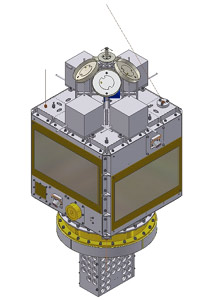FalconSat 3 (original) (raw)
Please make a donation to support Gunter's Space Page.
Thank you very much for visiting Gunter's Space Page. I hope that this site is useful and informative for you.
If you appreciate the information provided on this site, please consider supporting my work by making a simple and secure donation via PayPal. Please help to run the website and keep everything free of charge. Thank you very much.

FalconSat 3 [USAF]
FalconSAT-3, is a 50 kg microsatellite being developed by faculty and cadets, and is the Air Force Academy's first attempt at achieving three axis attitude determination and control (ADCS). FalconSAT-3 will carry three payloads to conduct DoD research. The attitude requirements for FalconSAT-3 include pointing the satellite within +/- five degrees of ram direction, as well as attitude knowledge to within one degree. FalconSAT-3 will provide sophisticated characterization of plasma turbulence in the F region ionosphere. Significant advances in technology have enabled miniaturization of instruments that enable comprehensive measurements of both ambient and spacecraft-specific turbulence.
The three primary experiments include
- the Flat Plasma Spectrometer (FLAPS), a planar electrostatic analyzer used to measure ion spectra differential in energy with a DE/E ~ 4%;
- the Plasma Local Anomalous Noise Environment (PLANE) experiment, a bifurcated retarding potential analyzer capable of distinguishing between ambient and spacecraft-induced turbulence; and
- the Micro-Propulsion Attitude Control System (MPACS), consisting of a set of Teflon-fueled pulsed plasma thrusters used to stabilize satellite attitude.
The FalconSAT-3 satellite bus is custom fabricated at the United States Air Force Academy (USAFA) and is manifested for launch into a 35� inclination, 560 km circular orbit in late 2006. Satellite operations will be managed from the USAFA ground station. Complementary ground-based observations of the ionosphere will be taken both at USAFA and at remote locations at low magnetic latitudes, where equatorial ionospheric processes are particularly effective at stimulating plasma turbulence.
In April 2017, U.S. Air Force Academy transfered control of its longest-running satellite to amateur radio operators.
| Nation: | USA |
|---|---|
| Type / Application: | Experimental |
| Operator: | U.S. Air Force Academy |
| Contractors: | U.S. Air Force Academy, SpaceQuest ? (bus) |
| Equipment: | FLAPS, PLANE, MPACS |
| Configuration: | |
| Propulsion: | Teflon-fueled pulsed plasma thrusters |
| Power: | Solar cells, batteries |
| Lifetime: | |
| Mass: | 50 kg |
| Orbit: | 560 km × 560 km, 35� |
| Satellite | COSPAR | Date | LS | Launch Vehicle | Remarks |
|---|---|---|---|---|---|
| FalconSat 3 | 2007-006E | 09.03.2007 | CC SLC-41 | Atlas-5(401) | with ASTRO, NEXTSat-CSC, STPSat 1, CFESat, MidSTAR 1 |